Tim McGiven's Blog, page 15
June 20, 2024
Five Takeaways from WordCamp Europe 2024 (From a First-Time WordCamp Attendee)
This year’s WordCamp Europe was held in Torino, Italy, the capital city of the Piedmont region in northern Italy. Torino is known for its rich automotive history, beautiful architecture, and, of course, incredible food.
From June 13-15, 2024, over 2,500 folks from the WordPress community, including many of us from the WordPress.com team, came together to learn, connect, and give back to the WordPress project that powers over 43% of the entire internet.
I joined the WordPress.com team back in January of this year, so WordCamp Europe 2024 was my first WordCamp experience. In today’s post, I thought it might be interesting to hear about the conference from a first-timer, especially if you’re considering attending a WordCamp or WordPress meetup in the future.
Here are my top five takeaways from my very first WordCamp:
1. In-person connection is powerful.If your typical workday looks similar to mine––sitting at a desk at your house all day by yourself––going to a conference as large as WordCamp Europe may be a wee bit out of your comfort zone. It certainly was out of mine.
That said, I’ve recently found myself craving in-person connection after the pandemic and working almost exclusively from home for over eight years. Not only did attending this conference just get me out of my normal routine, it allowed me to connect with folks who love the tool I’ve used personally and professionally for over a decade: WordPress.
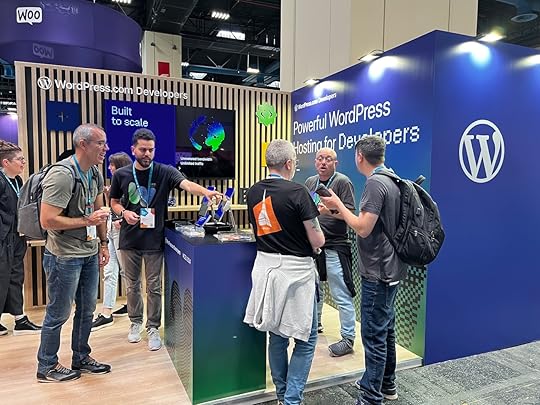
I staffed the WordPress.com booth, so I had a ton of opportunities to chat with other business owners, developers, creators, and makers over the course of the conference. I actually talked with a few fellow self-taught women developers like me, and I walked away feeling inspired, motivated, and just really thankful to be a part of this community.
But the best conversations happened in places I wouldn’t have expected: over spritzes, grabbing a cafe at the venue, or just walking around the city.
Embracing connection was a big focus of Matt’s final keynote speech during the event, and I couldn’t agree more. Events like WordCamps allow for swapping ideas, collaborating and troubleshooting, and experiencing a sense of community that you just don’t get while sitting behind a computer.
That said, if large-scale conferences like a flagship WordCamp just aren’t for you, try checking out a local WordPress meetup to connect with other like-minded folks in your community.
2. It takes a ton of people to make WordCamps great.One of the most moving parts of WordCamp Europe was at the very end when all of the volunteers and organizers were called to the stage; it’s truly amazing just how many people need to be involved to make an event like WordCamp actually happen.
 Screenshot from the WordCamp Europe 2024 livestream on YouTube
Screenshot from the WordCamp Europe 2024 livestream on YouTubeEverything was smooth and well-organized, and the volunteers and organizers could not have been more helpful. Their enthusiasm about the event, WordPress, and community in general throughout the conference was infectious.
WordCamps and local WordPress meetups are always looking for volunteers; donating your time and expertise for events and meetups like this are a great way to give back to the WordPress project and community.
And if you’re an organizer of your local WordPress meetup, check out this post for information on how you can get a free WordPress.com website for your local meetup.
3. Contributor Day isn’t intimidating for a first-timer.I’ve never contributed to WordPress core, but it was one of my goals for this year. That’s why I was so excited to participate in Contributor Day at WordCamp Europe.
If you’re unfamiliar with Contributor Day, it’s an event that usually kicks off a WordCamp. Teams focus on contributing to the WordPress open source project, with groups focused on code, support, translations, sustainability, inclusion, and more.
After listening to all of the team presentations, I decided to join the Accessibility team. Accessibility is something that has always interested me, but it’s also something I don’t have a ton of experience with.
That said, my inexperience wasn’t just accepted, it was actively welcomed.
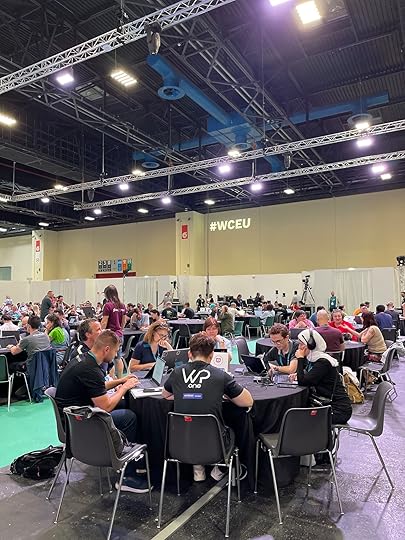
Once I got to the Accessibility team table, I was immediately greeted and welcomed. Then I paired with a fellow contributor, Marco Acato from Acato Digital Agency, to test the accessibility of a new theme for the WordPress theme repository.
I learned so much, asked a ton of questions, and felt surprisingly accomplished after just a few hours of testing this theme. We were actually able to publish feedback for the theme developer at the end of the day as well.
Contributor Day gave me an even deeper appreciation for the entire community that supports the WordPress project every single day. So much work and effort goes into maintaining and improving this tool that millions of websites across the world rely on to run their businesses, amplify their messages, and stay in touch with others. I felt so grateful to have been a part of it during Contributor Day and would encourage any other first-timers to attend a Contributor Day in the future as well.
Luckily, WordPress core is always looking for volunteers and contributors; check out this guide or the new Contributor Mentorship Program if you’re interested in becoming a contributor yourself.
4. Torino was a great host city, and the WordCamp team made navigating a new city easy.Between attending Contributor Day and sessions, to checking out sponsor booths and attending side events, I didn’t think we’d have a ton of time to actually see the city or Torino.
I actually had plenty of time to explore with my coworkers, eat pizza every single day, and scope out the best gelato spots outside of conference hours.

The WordCamp Europe team did a great job preparing attendees to make the most of our time in the city as well; their travel guides helped me feel confident navigating the city and finding some of the foods that come from this area in Italy.
As a first-timer in Torino, I really appreciated the extra work that the WordCamp team did to ensure everyone had a chance to explore and experience the city.
5. Pizza really is poetry.I would be remiss to not mention the food that we ate during our time in our host city! While we like to say that “Code is poetry” around here, so is pizza.
One of my very favorite memories from the event was the branding. The design team for WordCamp Europe 2024 added subtle nods to our host country throughout the venue, which was incredibly clever and well-done.

And while pizza is indeed poetry, it’s even better when shared amongst coworkers, friends, and people who get excited about the same things that excite you.
 Wrapping up
Wrapping upI loved my time at WordCamp Europe, and I’m already looking forward to the next time I can connect face-to-face with the WordPress community.
Were you at WordCamp Europe this year? Leave a comment with your favorite memory from the event below.
June 19, 2024
Your Eagle-Eyed Host: Inside WordPress.com’s World-Class Security Features
It’s never been easier to create a website—especially with WordPress.com—but keeping that site secure can be challenging. When you host with WordPress.com, though, we do the heavy lifting for you and let you focus on the fun of creating your dream website. Whether you’re a blogger, entrepreneur, or hobbyist, our top-notch security features safeguard your site day and night so that you don’t need to stress.
Whether you’ve known about it or not, we’ve long been scanning and monitoring your site’s files to catch and remove threats. Let’s dig in just a bit more.
Built-in protection at your fingertips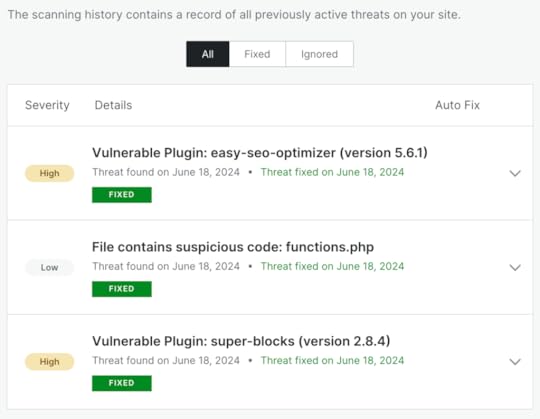 Scan history is available on higher-tier plans
Scan history is available on higher-tier plansUsing Automattic’s homegrown Jetpack software, every WordPress.com site is scanned on a daily basis for dangerous plugins, themes, malware, and other vulnerabilities. Once weaknesses are spotted, our security team swiftly resolves the issues, updating or reverting files as needed depending on the problem.
Perhaps the best part is that we offer this peace of mind for free, on every plan. This certainly isn’t the case everywhere. Many WordPress hosts charge for the type of protection that WordPress.com offers on all of our website plans.
Plus, you don’t have to do a thing to activate or maintain these security features. Our scanning tools are up and running as soon as your site is created. You can rest easy knowing that you have the web’s best security guards working on your behalf.
Why does website security even matter?It’s possible you’ve never before thought of the importance of website security. The reality of the modern web, however, is that bad actors are out there looking to take advantage of you and your site’s visitors.
If your site is hacked, it’s liable to cause serious damage to your reputation and your livelihood (not to mention your emotional well-being). Hackers can manipulate your website’s data, steal information from you or your users (including passwords), install and execute malicious code, and even distribute the malicious code to your visitors, infecting their sites and machines. It’s not an insignificant problem or threat, that’s for sure.
Jetpack’s web application firewall (WAF) monitors every request to your site and blocks requests from anything malicious. Our team of security experts continually updates the web application firewall’s rules to ensure you are protected against the most up‑to‑date threats. You don’t have time for downtime.
Even more robust security tools are available
On our higher-tier plans you also have access to the scan history, which shows a record of all previous threats on your site. Additionally, you’ll have access to real-time backups, real-time security scans, malware removal, spam protection, and vulnerability notifications for core code and plugins.
Set it and forget itAt WordPress.com, we want you dreaming big rather than spending your energy worrying about your website’s security. This is why we provide automatically-installed best-in-class monitoring with no extra charge, on every single plan.
And our security features will grow right alongside you; whether your dream is to blog about your adorable cats, highlight your stunning landscape photography, or build a home base for your budding technology startup, we have your back. Learn more about all our security features or get started building right now:
Get startedJune 15, 2024
Host Your WordPress Meetup Site for Free on WordPress.com
WordPress has always been built around its community, and local meetups are a huge part of it.
To encourage even more in-person connection, we’re happy to let you know that you can now host your WordPress meetup for free on WordPress.com and access all of the benefits of our popular Creator plan. You’ll get a free domain name, unlimited bandwidth, and the web’s best spam and security protection so you can focus on the real magic of WordPress: the community.
At WordCamp Europe 2024 yesterday, Matt Mullenweg, co-founder of the WordPress project, gave a keynote where he talked about 11 important opinions to keep in mind while working on WordPress. Unsurprisingly, most of these opinions revolve around the craving for human connection. So when Matteo Spirandelli, co-organizer of WordPress Meetup Milano, asked in the Q&A whether their meetup could have a complimentary WordPress.com site, my answer was an emphatic “yes!”
Connecting with your local WordPress community is a great way to foster those connections, and WordPress.com wants to help by offering free websites on our Creator plan for local WordPress meetups.
If you are an organizer of an existing WordPress meetup, here’s how you can redeem your complimentary website:
Ready to join your local WordPress community? Find a WordPress meetup in your area to connect with other writers, business owners, developers, and folks from all walks of life. Here are a few of the upcoming events around the globe:
WordPress Networking Lunch with Chattanooga / Cleveland Area WordPress Meetup on Tuesday, June 18th at 12 pm EDTWordPress + ACF = Power² with the Basel WordPress Meetup Group on Thursday, June 20th at 7:00 PM CESTWordPress Website Speed Hacks for 2024 with WordPress Sydney on Wednesday, June 26th at 6 pm AESTThe WordPress project also has a great guide to starting your own WordPress meetup.
It was truly a pleasure to connect with so many of you at WordCamp Europe 2024. We’ll see you at WordCamp US in Portland, Oregon in September!

June 14, 2024
WordPress.com Partner Spotlight: Do the Woo 4.0
Editor’s note: This is a guest post from Bob Dunn, founder of Do the Woo, a podcast channel elevating voices of the WooCommerce and WordPress community.
It was early 2023, and I’d been searching for the perfect direction for Do the Woo, the podcast and site we first launched in 2016. I’d made some small steps, but I hadn’t yet found the grand recipe. I just knew that with the shows changing format, the site needed to as well.
Finally, it came to me, as clear as day.
If I was going to do a major site redesign, I wanted it to be built on blocks. I wanted a full-site editor. And I wanted a hosting platform that would take care of things so I could focus on the content. That meant WordPress.com.
So that fall, around the time of WordCamp US, I sent Matt Mullenweg a message. Just as I’d shared ideas with Matt in the past, I did so now—except now was my vision for the next Do the Woo, and the platform I thought it should be built upon. Incredibly, he saw what I saw, and not long after a dream partnership formed: I began working with WordPress.com’s special projects team on the next version of Do the Woo.
Between then and now, a lot has happened. A lot of wireframes, a lot of discussion, a lot of iteration. The WordPress.com team has done incredible work throughout. During my visit to CloudFest in Germany, we even soft-launched the new site. But now it’s official. Today, on the first day of WordCamp Europe, I’m excited to announce Do the Woo 4.0: the podcast by WordPress and WooCommerce builder and business community, for the community.
There are so many things I could tell you about the new site, but it’s all right there on DotheWoo.io, so head over there to learn about our launch. And stay tuned—there’s lots of exciting stuff in the works.
This wouldn’t have happened without the folks from WordPress.com, WooCommerce, and Jetpack. I’m thrilled with what they’ve done with the site, and even more thrilled that my new home is on WordPress.com. I can’t wait for you to join our journey. Let’s do the Woo!
Get a 15% discount on your own WordPress.com siteJune 10, 2024
Say Hello to the Hosting Dashboard
At WordPress.com, we’re always striving to make your web management experience as seamless as possible. Our latest update marks another significant step in that direction. Today, we’re happy to share a new unified dashboard where you can manage and view your sites and domains.
Whether you’re a blogger, a small business owner, or a developer, this interface was designed with your needs in mind.
Let’s explore! And if you want to try it out yourself before getting a tour, simply head to WordPress.com/sites.
Navigate multiple sites with easeGetting a bird’s-eye view of your WordPress.com sites has never been easier. With our new site management panel, your admin tools have been brought into one place. In addition to finding a comprehensive summary of your site’s plan and storage usage, you also have access to “Quick actions” like “Write post,” “See Jetpack Stats,” and more.
If your site is on a plugin-enabled Creator or Entrepreneur plan, there are tabs for developer-friendly tools like the latest GitHub deployments, server logs, staging sites, and additional server configuration settings.
This intuitive new dashboard serves as a convenient bridge between the global view of all your sites and individual site management within wp-admin.
Centralized domain management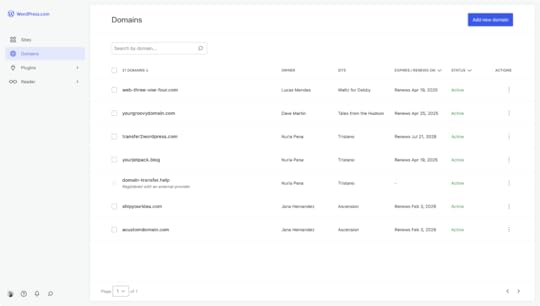
When you reach the Domains page, you’ll see a list of all your domains that are registered with us, regardless of whether they’re connected to a WordPress.com site. In addition to quickly seeing each domain’s expiration date and status (“Active,” “Expiring soon,” etc.), you can easily access DNS records, contact information, and other settings.
Install and update plugins, too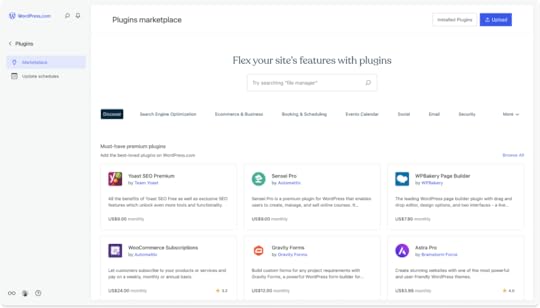
When you land on the Plugins page, you’ll immediately find yourself at the built-in marketplace. From here, you can search for new plugins and then add them to one of your sites with ease. You can also manage and create schedules for updating your plugins rather than relying on manual updates.
One more thing: wp-admin at your fingertipsFor those of you with websites on plugin-enabled plans (Creator and Entrepreneur), you now have the option of seeing the classic wp-admin dashboard instead of the WordPress.com “My Home” page. This is especially useful for folks who utilize multiple WordPress hosts, often on behalf of clients, and want to have the same visual experience between every site. Or, perhaps you learned the ropes with that classic WordPress dashboard and don’t want to leave it behind.
To enable the wp-admin interface, visit “Settings” → “General” and then scroll down to the “Admin interface style” section. From there you can select “Classic” (wp-admin) or “Default.”
We’re just getting startedAt WordPress.com, we’re continuously refining and improving our platform based on your feedback. This streamlined dashboard is just one step along the bigger journey. We want to hear from you—your insights drive our innovation. So, dive in, explore the new features, and let us know what you think!
Visit the new hosting dashboardJune 7, 2024
Preventing WordPress Design Disasters
Broken images, mismatched colors, and menu links that go nowhere—we’ve all experienced these design disasters online. Sometimes, these problems are caused by clients accidentally breaking something when accessing a website’s backend. In today’s Build and Beyond video, Jamie Marsland provides five ideas for how builders and clients can work together to prevent the kinds of problems that keep people from engaging with a website.
Ready to get going? Get started with WordPress.com today:
Start buildingJune 5, 2024
Maximize Your Agency’s Potential by Partnering With Automattic and WordPress.com
Automattic, WordPress.com’s parent company, is home to an unbeatable suite of publishing and small business tools. Jetpack, built into every WordPress.com site, offers performance, security, and growth tools. WooCommerce is trusted by more than 3.6 million online shops, making it the number-one open source ecommerce platform on the internet. And our very own hosting solutions at WordPress.com are ideal for freelancers, developers, and agencies alike.
Today, we’re bringing all those services under one roof by launching a new program—one that gives agencies robust tools, dedicated support, and extensive resources so they can thrive like never before. Welcome to Automattic for Agencies .
Boost your agency’s revenue by streamlining operations via new multi-site purchasing and management tools, opening new revenue streams with our robust referral program (which includes great bonuses and incentives), and enhancing your client offerings through re-selling a diverse range of services. With new volume discounts for WordPress.com hosting (more on that below), you can even save money while you take advantage of our unparalleled support and web infrastructure.
Learn more about the agency programTable of contents
What Automattic for Agencies offers Elevated earningsA centralized dashboard for seamless operationsUnparalleled integrated supportSecurity and confidence with every updateDiscounts, incentives, and bonuses—oh my! Who is this program for?Learn more about Automattic for Agencies What Automattic for Agencies offers Elevated earningsAs a valued member of our agency program, you’ll be able to refer and resell a suite of Automattic products from hosting to e-commerce solutions, and enjoy additional bonuses for certain products. You’ll have all the tools you need to supercharge your client’s websites and expand your revenue streams.
A centralized dashboard for seamless operationsOur all-in-one dashboard has been designed from the ground up for maximum efficiency. Simplify your billing and site management processes, purchase and resell products with flexible billing options, and manage multiple client sites with ease.
Unparalleled integrated supportOur integrated support system spans across the Automattic universe, providing your agency with consistent and cohesive technical help and driving faster project turnaround times.
Security and confidence with every updateReceive instant notifications about updates or security alerts, and apply those updates swiftly to maintain peak site performance and security.
Discounts, incentives, and bonuses—oh my!As a referrer of WordPress.com’s services, your agency will receive a 20% revenue share on new subscriptions and 50% on new migrations to WordPress.com from other hosting providers. And through the end of July 2024, we’re throwing in an additional $100 bonus for every referred migration.
We’re also happy to introduce volume discounts on WordPress.com hosting. Discounts start when you purchase a minimum of three sites through our program. At 10 sites or more, the cost is just $10/month per site.
Click here to learn more about these incentives, as well as those for Jetpack and WooCommerce.
Who is this program for?Automattic for Agencies is tailor-made for agencies that deliver custom solutions catering to the unique demands of their clients. It’s an ideal match for medium-sized agencies offering a full spectrum of digital services.
If you’re interested in earning commissions by recommending Automattic’s products and services to a wider audience, consider joining the Automattic Affiliates program. This program is especially beneficial for content creators, influencers, educators, and anyone interested in speaking about Automattic products online.
Learn more about Automattic for AgenciesTake the first step by setting up your account today. To learn more, visit WordPress.com/for-agencies or click below to apply for early access:
Get started todayJune 3, 2024
Become a WordPress.com Affiliate and Elevate Your Earnings
WordPress.com is looking for affiliates to help promote our suite of open-source products, including WordPress.com hosting, domains, Express Website Design Service, WP Job Manager, and more! If you’ve got an audience, you’ve got the potential to elevate your earnings by becoming an affiliate for one or more of our eligible products.
Getting started is simple. Sign up with your details and our team of experts will verify your account. Once approved, you can start creating affiliate campaigns for the products you’ve selected—all from your personalized dashboard.
Apply to become an affiliateNo matter if you’re an influencer, blogger, or reporter, WordPress.com doesn’t take much selling to get your audience on board, thanks to a strong reputation and range of built-in publishing, monetization, and promotion tools. So you can spend less time thinking about how to pitch WordPress.com and Automattic’s related products to your existing audience, and more time growing your business. As you start generating signups, you’ll see payouts of up to 100%, and a much longer than normal 30-day cookie period, so you’ll still get those commissions up to 30 days after someone clicks your links.
Our convenient dashboard makes your affiliate marketing easier as you manage and track all your promotions for WordPress.com products in one place. Monitor your campaign’s performance, make data-driven adjustments and optimizations, and watch your commissions soar. Plus, our creative templates and tools make it easy to create content to help drive affiliate traffic.
WordPress.comBecome an affiliate for any of the following WordPress.com products and services:
WordPress.com hosting. Lightning-fast, secure hosting designed from the ground up for WordPress.
WordPress.com domains. Promote 350+ domain extensions, from .com to .xyz, and everything in between.
Express Website Design Service. Sites designed and built for you in four days or less by our WordPress.com Happiness Engineers.
WP Job Manager. The open source job board plugin, powering job listings for 100,000+ websites.
Sensei. The best plugin to create and sell interactive online courses with WordPress.
Our offerings extend beyond WordPress.com, too. If your audience is interested in Automattic’s other products, you can also become an affiliate for any of the following brands and manage all your campaigns in one place:
WooCommerceAn extensive range of vetted WooCommerce extensions, themes, and services such as WooCommerce Subscriptions, Product Bundles, and WooCommerce Zapier.
JetpackSecurity, performance, and marketing tools made for WordPress sites by the WordPress experts, including Jetpack Security, Complete, Stats, Scan, and more.
Akismet Anti-SpamScalable AI-powered comment, form, and text spam filtering with 99.99% accuracy.
Ready to partner with us and grow your income with WordPress.com or our other Automattic brands? Learn more and sign up now at wordpress.com/affiliates.
Apply to become an affiliateMay 30, 2024
Scalable WordPress Hosting for Developers
WordPress powers forty-three percent of all websites, supporting everything from small hobby sites to major sites such as Rolling Stone, TechCrunch, and even The White House.
If you want your WordPress website to scale and accommodate anywhere from 10 to millions of site visits a month, you need to choose your hosting wisely. When a site is business-critical, you need scalable hosting that can support its performance and security requirements.
WordPress.com is a managed WordPress hosting solution that accommodates the growing demands of your site, allowing it to scale with you and your clients.
Explore WordPress.com hostingIn this article, we’ll take a look at the importance of scalable WordPress hosting, as well as how to ensure that your sites are as highly available, secure, and performant as possible. We’ll cover:
Shared vs managed WordPress hostingWhy managed hosting is best for growing sitesSecurityCost containmentScalabilityPerformanceHow to make your site more scalableUse a Content Delivery NetworkCachingAutoloadingWrapping upShared vs managed WordPress hostingWhen evaluating WordPress hosting options in terms of scalability, it’s important to understand the differences between shared hosting and managed hosting.

Shared hosting is like going to the gym where you need to share access to all of the equipment like treadmills and weights. If there are too many people using the treadmills, you may need to wait your turn, which can impact the amount of time you need to spend at the gym to get your desired workout.
With shared hosting, your website shares server space and resources with other websites; if one website gets a lot of visitors or needs more resources, it can slow down the performance for everyone else on the same server.
Managed hosting, like what we offer at WordPress.com, is like having a home gym. The equipment is yours, and you can use it whenever you want––no need to wait in line!
With managed hosting, your website has its own dedicated server and resources, so you don’t have to worry about other websites affecting its performance. Not only that, similar to how a personal trainer establishes your workout schedule and nutritional suggestions, a managed hosting provider manages all of the technical stuff for your website, like keeping it safe and making sure it runs smoothly.
Building upon the workout analogy, as your goals change, whether it’s weight loss, muscle gain, or general fitness, a personal trainer will customize your workout plan to meet the desired goals. Similarly, when the demand of your website grows with a larger audience or new service requirements, a managed hosting provider ensures appropriate resources are allocated to support those needs so that your website continues to perform in high traffic.
So when trying to find the best hosting solution for scalability, managed hosting is typically recommended over shared hosting.
Why managed hosting is best for growing sitesShared hosting can be a great budget choice to start, especially for small-scale hobby sites and other sites that aren’t business-critical. However, when you are working for clients or customers, you often have requirements that even the best shared hosting providers aren’t always equipped to handle.
Especially when developing a complex site, it’s important to have hosting that can grow with a site, as your host will need to support more traffic, a greater number of plugins, or different types of editorial content.
Unfortunately, many shared WordPress hosting platforms have some difficulty meeting this need, and there are a number of common problems you may face when using shared hosting:
SecuritySecurity can be an issue with some of the shared hosting providers due to the fact that multiple sites are sharing resources. Depending on how the infrastructure is configured, a vulnerable plugin on someone else’s site could affect yours, even if you keep all your plugins, themes, and WordPress core up to date!
As your site grows, you’ll also likely need to add more users with permissions to log in and manage the site. Thanks to WordPress’s user roles, it’s easy to restrict what parts of a site users are able to change. However, as this list of users grows, so do the opportunities for less-secure practices to sneak into your site and potentially compromise things.
One major concern is authenticating users who need access to the backend of your site. With a solution like WordPress.com, you get our Secure Sign-On, which allows you to use a single set of credentials to access both the WordPress.com dashboard and the backend WP Admin dashboard of any of your sites, quickly and securely. It also allows you to enforce two-factor authentication or security key authentication to ensure that everyone who has access to your site is accessing it in the most secure way possible.
Since eligible WordPress.com plans also run on WP Cloud’s architecture, your site gets double protection through the use of their Linux namespaces and control groups; they separate your site data from other sites and users.
WP Cloud also encrypts site traffic with Transport Layer Security (TLS), protecting any data your users share with your website (and vice versa).
Cost containmentA common pattern among shared hosting companies is to be relatively cheap but charge for additional features a la carte, such as a content delivery network (CDN) or increased bandwidth.
While this might make sense for someone just starting out, more advanced sites may need additional features, which can rapidly make hosting your site an expensive proposition. A better choice is finding a managed hosting provider that gives you everything you need to scale your site for a flat rate.
With WordPress.com’s eligible plans, you get access to WP Cloud’s ultra-powerful Global Edge Caching, unrestricted bandwidth, a site accelerator CDN, and high-burst capacity, all included within your plan.
ScalabilityAs your site scales, you’ll be adding more content and getting more traffic. Your server needs to handle the increased demands and load that a bigger, more highly-trafficked site requires. A managed hosting company handles traffic spikes and increased demands on the server behind the scenes, so that you can rest assured that your site won’t be held back by the hosting infrastructure it sits on.
When comparing hosts, the ability to handle increased infrastructure demands should be a primary consideration; you don’t want your website to go down just when it’s getting more exposure than normal or while your business is growing.
In independent, third-party testing, WordPress.com stands out for its top tier performance, even under increased load. Your site will also load quickly at scale due to the quantity of PHP workers available from WP Cloud for each eligible WordPress.com site.
PHP workers process PHP code to build pages, execute processes, and fulfill requests. The number of PHP workers provided by your host impacts the amount of uncached requests your site can handle at once. The more PHP workers your site has, the quicker content can be shown to your audience.
Our custom resource management system automatically scales to over 100 PHP workers that will support your sites and keep things running efficiently, regardless of the number of visitors trying to access them at once.
 Performance
PerformanceOne of the major downsides to shared hosting is speed. Because you’re sharing the same server and resources with many other customers, there are limits to how fast your site can load, especially if your site or someone else’s site on your shared server experiences heavy traffic. And as you probably already know, sites that perform better and load more quickly are more attractive to customers and do more business overall.
Even though many shared hosting solutions claim to offer “unlimited” bandwidth or other resources, there are practical infrastructure limitations due to the fact that you’re sharing with others.
As your site grows, shared hosting can also lead to decreased stability and uptime. With multiple sites competing for resources, there’s a higher likelihood of performance bottlenecks and server strain, potentially causing frequent downtimes and slower loading speeds. Consequently, you may find yourself spending more time on maintenance tasks to address these issues.
With WordPress.com, your site resources will scale with your website as it grows, so you never need to pay overage charges or worry about being too successful. Eligible WordPress.com hosting plans include WP Cloud’s robust and automated burst scaling to ensure that your website will never slow down or crash as a result of heavy traffic spikes or excessive concurrent users.
How to make your site more scalableNo matter where your site is hosted, there are some best practices that you can implement to make it more scalable:
Use a Content Delivery NetworkA Content Delivery Network (CDN) provider has dedicated servers around the country or world that can serve your site’s static assets quickly, dramatically improving page load time. Serving static assets from a dedicated CDN, instead of serving them from your web server, frees up your web server to process requests to the actual site, and helps these resources load faster for users around the world. When you can, you should always use a CDN to make your site load more efficiently.
If you decide to use WordPress.com for your site’s hosting, you can take advantage of the Site Accelerator from Jetpack and offload the responsibility of serving static assets, such as images, JavaScript, and CSS, to the CDN. This will ensure that even as you add more media to your site, performance won’t be affected, because the heavy lifting will be handled by your CDN.
CachingAnother way to make your WordPress site more scalable is to effectively utilize caching. Hitting the database or an external API to fetch data for rendering a page can slow down your site. By caching some of these performance-impacting pieces, you can significantly speed up page load and ensure your site remains performant.
A form of caching uses the transient system built into WordPress, which can store the result of a long-running database query or API call in the wp_options table of the WordPress database, allowing quick lookups. In general, any data that takes a long time to generate is a good fit for a transient. Transients expire over time, so they won’t always be cached, but when they are, they can significantly speed up page load time. Check out this complete guide on WordPress Transients to learn more.
There are also caching plugins that do some of this work for you. However, in many cases, hosting providers implement their own caching systems that conflict with these plugins, so be sure to check with your hosting provider to see if the caching plugins you’re interested in are compatible with their infrastructure.
WordPress.com has all these caching solutions built-in, there’s no need to use additional plugins to handle caching.
AutoloadingAnother improvement you can make to your site, regardless of your hosting provider, is checking how many autoloaded queries you have. By default, certain options in WordPress are autoloaded, meaning they’re queried from the database on every page load, regardless of whether they’re needed on that particular page.
By only autoloading the options that are actually required everywhere on your site, you can reduce the number of database queries made on each page load, which will make your site load much more efficiently.
If you’re not sure what’s getting autoloaded, you can check the total size of all the options you are autoloading by running the following SQL query:
SELECT SUM(LENGTH(option_value)) as autoload_size FROM wp_options WHERE autoload=’yes’;This will give you the total size, in kilobytes, of options that are autoloading. If this is more than a megabyte, you should investigate what you are storing in wp-options and what’s being autoloaded to see if there are any optimizations you can make here.
Wrapping upWhen it comes to building and growing your WordPress site, the last thing you want to worry about is your hosting provider not being able to handle your expansion. By choosing scalable, managed WordPress hosting that takes care of all of the core features required to host your site, you’ll be able to grow without issue, keeping your customers and users happy.
You can rely on WordPress.com’s managed WordPress hosting as a fast, secure hosting environment that will scale with you and your clients’ success.
May 29, 2024
Studio: Now Available for Windows
We recently launched Studio, our free and open source local WordPress development environment, for MacOS, and we’re happy to share that the Windows version of Studio is now available!
Download Studio for WindowsAs a reminder, we’ve built Studio to be the fastest and simplest way to build WordPress sites locally.
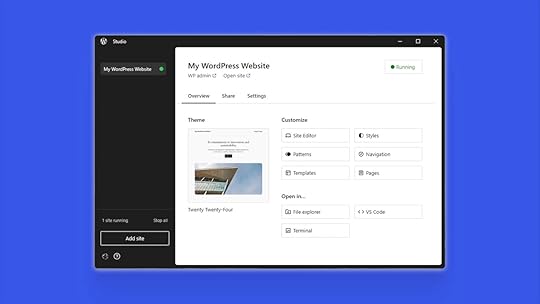 A new default local WordPress development environment
A new default local WordPress development environmentIn less than one month, Studio has thousands of active users, and those users have created hundreds of demo sites. Plus, since Studio is open source, we’ve received and merged bug fixes and enhancements from community users over on GitHub.
It has been so exciting to see the WordPress community embrace a better local development setup with Studio:
Last week I streamed creating a To-do app with the Interactivity API and I tried Studio by @wordpressdotcom.
— Ryan Welcher (@ryanwelcher) April 29, 2024
Not only was it rock solid, but it has this REALLY COOL feature to host your local site.
Wow! Local WordPress development 2.0 – install, work, and go straight into Visual Studio if you need to. Mac for now, but a Windows version is on its way.
— Anne Bovelett (@Bovelett) April 24, 2024
PS Studio is open source, it can be forked. https://t.co/k5jaklVHIx
Of course, we knew that a Windows version of Studio was also needed, as over 25% of WordPress developers develop on a Windows machine. We worked on a Windows version alongside the Mac version, but the Windows version required us to solve some additional challenges before making it widely available.
Plus, developers started requesting it immediately:
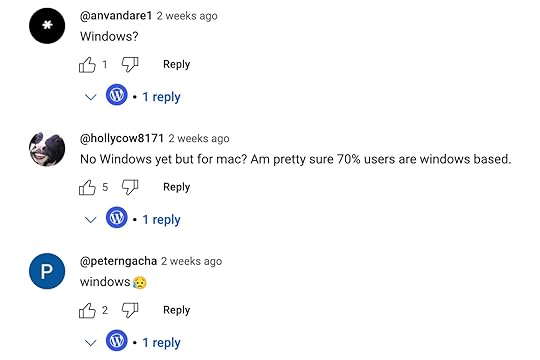 Comments on our Studio announcement videoDownload Studio for Windows for free today
Comments on our Studio announcement videoDownload Studio for Windows for free todayOur free Windows version of Studio is now available, and you can get up and running with a local site on your Windows computer in just a few clicks:
Download Studio for Windows.Install and open Studio.Click Add site, and you’re done!Note: If you use an early version of Studio for Windows (downloaded before May 29, 2024), please follow the steps above to install the latest version to ensure you receive updates when available.
Just like in our Mac version of Studio, Studio for Windows allows you to access WP Admin, the Site Editor, global styles, and patterns, all with just one click—and without needing to remember and enter a username or password. You can also easily open your site code in File Explorer, PhpStorm, VS Code, or your terminal for easy editing and shipping.
You can also effortlessly create demo sites on the Windows version of Studio so you can share your local work with your clients, teams, and colleagues.
Development on Studio is fast and quick thanks to our use of WordPress Playground helping us run the app behind the scenes.
 Ready to get building?
Ready to get building?Download Studio for Windows today to start creating and running WordPress sites directly on your local Windows machine.
You can also explore the Studio documentation for more step-by-step instructions for using Studio, and if you have any thoughts, feedback, or enhancement requests, submit an issue over on GitHub.
Tim McGiven's Blog
- Tim McGiven's profile
- 1 follower




